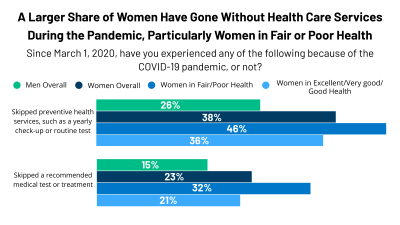 Women’s Experiences with Health Care During the COVID-19 Pandemic: Findings from the KFF Women’s Health Survey
Issue Brief
Women’s Experiences with Health Care During the COVID-19 Pandemic: Findings from the KFF Women’s Health Survey
Issue Brief
This brief provides new data from the KFF Women’s Health Survey, a nationally representative survey of 3,661 women and 1,144 men ages 18-64 that was conducted November 19, 2020 – December 17, 2020. In this brief, we document how experiences accessing health care during the COVID-19 pandemic have differed by gender, age, race/ethnicity, insurance coverage, and income and what this could mean moving forward.